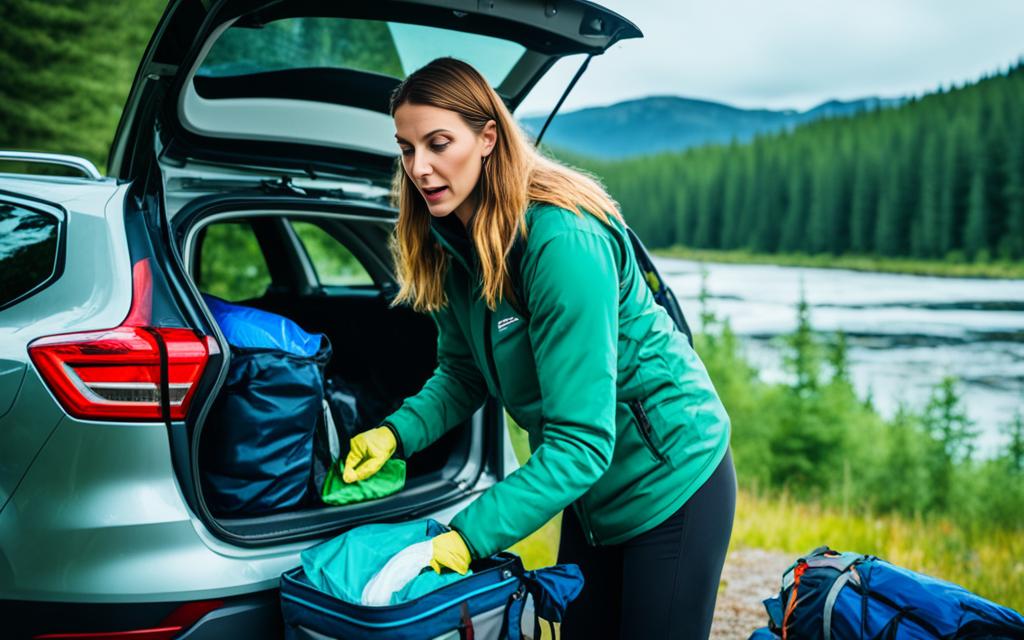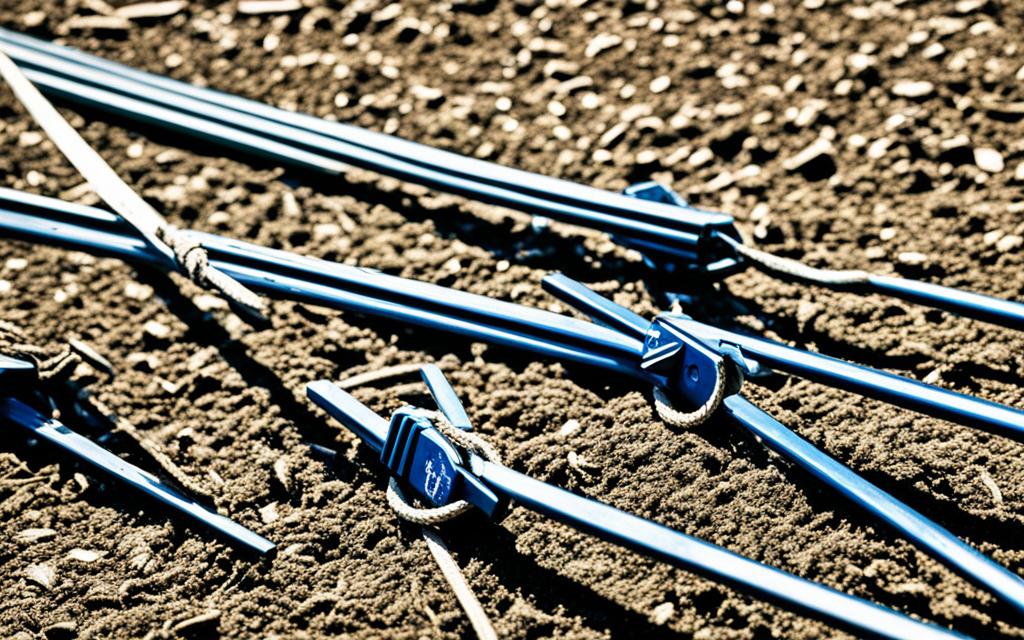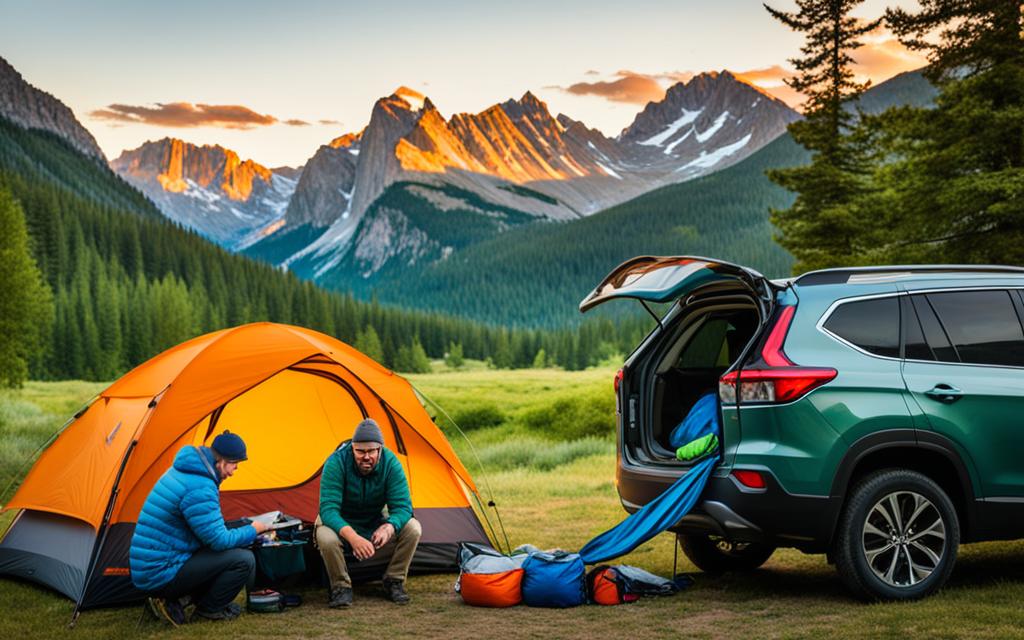Welcome to our comprehensive guide on setting up a tent for camping using your car. Whether you’re a seasoned outdoor enthusiast or new to the world of camping, this article will equip you with the essential knowledge to enjoy a hassle-free camping experience.
Setting up a tent is a crucial part of car camping. It provides you with shelter, comfort, and a cozy space to rest after a day filled with outdoor adventures. By following the steps outlined in this guide, you’ll be able to effortlessly set up your tent and create a home away from home in nature.
In this article, we’ll cover various aspects of car camping, from choosing the right tent to preparing your car and finding the perfect campsite. We’ll also provide you with tips on securing your tent, creating a comfortable campsite, and packing up efficiently when it’s time to depart.
Key Takeaways:
- Setting up a tent for camping using your car is an essential skill for a successful outdoor adventure.
- Choosing the right tent size, considering weather resistance, and additional features are important factors to consider.
- Gathering the necessary camping equipment and accessories will ensure a comfortable and enjoyable experience.
- Finding a suitable campsite with car-friendly facilities and breathtaking views is crucial.
- Preparing your car and organizing camping gear is necessary for a smooth camping trip.
Choosing the Right Tent
Before setting up your tent, it is crucial to choose the right one for your camping needs. The perfect tent can make all the difference in ensuring a comfortable and enjoyable camping experience. Here are some important factors to consider when selecting a tent:
Tent Size and Capacity
One of the first things to consider is the size and capacity of the tent. Think about how many people will be sleeping in it and whether you’ll need extra space for gear. Keep in mind that manufacturers often provide a recommended occupancy, but it’s always wise to choose a tent with a slightly higher capacity to provide ample room for everyone.
Weather Resistance
When camping, it’s essential to be prepared for various weather conditions. Look for tents that offer great weather resistance, including rainfly covers, waterproof materials, and sturdy construction. Consider the expected weather during your camping trip and choose a tent that can withstand those conditions.
Additional Features
Another aspect to consider is the additional features a tent offers. Some tents come with built-in storage pockets, mesh windows for ventilation, or even separate sleeping compartments. Think about your specific needs and preferences, and choose a tent that provides the features that will enhance your camping experience.
Remember, choosing the right tent is not just about finding the most expensive or popular option. It’s about finding the one that suits your needs and camping style best.
In summary, when choosing the right tent, take the time to assess the size, capacity, weather resistance, and additional features. By selecting a tent that meets your specific requirements, you’ll set yourself up for a fantastic camping adventure.
Gathering the Necessary Equipment
In order to successfully set up a tent using your car, you will need to gather the necessary equipment. Having the right camping gear and tent accessories can contribute to a comfortable and enjoyable camping trip. Here are some essential items to consider:
Camping Equipment
When venturing into the great outdoors, it’s important to have the right camping equipment. Make sure to pack:
- Tents- Choose a tent suitable for your group size and weather conditions.
- Sleeping Bags and Sleeping Pads- Opt for sleeping bags that provide warmth and comfort, along with sleeping pads to cushion the ground beneath you.
- Camp Chairs- Relax and unwind around the campsite with comfortable camp chairs.
- Cooking Gear- Portable stoves, cookware, and utensils are essential for preparing meals.
- Coolers- Keep your food and beverages fresh with a reliable cooler.
Essentials for Car Camping
When camping with your car, there are a few additional essentials to consider:
- First Aid Kit- Be prepared for any minor injuries or accidents that may occur during your camping trip.
- Camping Lights- Illuminate your campsite with headlamps, lanterns, and portable lights.
- Camping Furniture- A folding table, collapsible washbasin, and other camping furniture can provide convenience and organization.
- Portable Power Source- To charge your electronic devices or power your camping gear, consider bringing a portable power bank or solar charger.
Tent Accessories
Enhance your tent setup with these useful accessories:
- Tent Footprint- Protect your tent’s floor from wear and tear with a tent footprint.
- Tent Stakes– Securely anchor your tent in place with sturdy tent stakes.
- Tent Repair Kit- Be prepared for any unexpected tears or damages with a tent repair kit.
- Tent Fan- Stay cool during warm nights with a portable tent fan.
By gathering these essential camping equipment and tent accessories, you’ll be well-equipped for a successful and enjoyable car camping experience. Remember to choose quality gear that suits your needs and ensures a comfortable stay in the great outdoors.
Finding the Perfect Campsite
The success of your camping trip depends on choosing a campsite that meets your needs and preferences. Consider the following campsite considerations to ensure a memorable experience:
- Accessibility: Look for campsites that are easily accessible by car, allowing you to conveniently transport your camping gear. This will save you time and effort, especially if you have heavy equipment or multiple supplies to carry.
- Facilities: Check if the campsite offers essential amenities such as toilets, showers, and potable water. These facilities are important for comfort and convenience during your stay.
- Safety: Prioritize your safety by selecting a campsite with well-maintained grounds, proper lighting, and security measures. Additionally, opt for campsites located in safe areas, away from potential hazards.
- Scenic Views: Immerse yourself in the beauty of nature by choosing a campsite with picturesque surroundings. Whether it’s a serene lakeside, a stunning mountain backdrop, or a lush forest, the scenic views will enhance your camping experience.
- Car-Friendly Facilities: If you’re planning a car camping trip, look for campsites that have car-friendly facilities such as designated parking spaces near campsites or camping spots that allow you to park your car next to your tent. This will make it easier to access your belongings and ensure convenience throughout your stay.
Consider these campsite considerations when choosing your ideal location for a satisfying camping adventure.
Preparing Your Car for Camping
Before setting up your tent, it is essential to prepare your car for camping. This will ensure a smooth and enjoyable camping experience. Here are some key steps to follow:
1. Organizing Camping Gear
Properly organizing your camping gear is crucial for easy access and efficient space utilization in your car. Use containers, bins, or storage bags to categorize and separate different items, such as cooking equipment, sleeping gear, and outdoor essentials. This will help you locate items quickly and prevent any damage during transit. Consider using storage solutions like rooftop cargo boxes or car-mounted cargo carriers to maximize space.
2. Car Maintenance
Prioritize your vehicle’s maintenance before heading out on a camping trip. Check the oil, coolant, and brake fluid levels, and inspect the tires for any signs of wear or damage. It’s also essential to have a spare tire and the necessary tools to change it. If your car is due for a service, schedule one before your camping adventure to ensure it is in optimal condition.
3. Adjustments for Camping Needs
Depending on your camping plans and the gear you intend to bring, you may need to make adjustments to your car’s setup. If you have a smaller vehicle, consider using a roof rack system to carry larger items like kayaks or bicycles. Additionally, invest in cargo nets or organizers to secure loose items and prevent them from shifting during transit. If you’re camping in a location with limited access to amenities, consider bringing additional water containers or a portable water filtration system.
“Properly organizing your camping gear is crucial for easy access and efficient space utilization in your car.”
By taking the time to prepare your car for camping, you’ll be able to set up your tent and enjoy your camping experience with ease. From organizing your gear to ensuring your car is in top condition, these preparations will contribute to a stress-free and memorable adventure.

Setting Up the Tent
Now that you have chosen the right tent, gathered the necessary equipment, and prepared your car, it’s time to set up your tent. Follow this step-by-step guide to pitch your tent like a pro.
1. Find a suitable location: Look for a level and clear area where you can easily set up your tent. Remove any rocks, sticks, or debris that may cause discomfort or damage to the tent floor.
2. Lay down the groundsheet: Place the groundsheet or footprint of your tent on the chosen spot. This helps protect the tent floor from moisture and sharp objects.
3. Assemble the tent poles: Take out the tent poles and connect them according to the manufacturer’s instructions. Insert the poles into the corresponding pole sleeves or grommets.
4. Raise the tent: Lift the tent canopy, starting from one corner. Gradually work your way around, inserting the poles into their designated sleeves or grommets. Gently lift the tent upright until it stands on its own.
5. Secure the tent: Stake out the corners of the tent using tent stakes. Insert each stake at a 45-degree angle away from the tent, ensuring they are fully driven into the ground. This provides stability and prevents the tent from shifting in windy conditions.
6. Adjust the tension: Check the tent body for any sagging fabric. Adjust the tension by tightening or loosening the guylines attached to the tent corners. This helps maintain the shape of the tent and improves wind resistance.
7. Attach the rainfly: If your tent comes with a rainfly, secure it over the tent body to provide additional protection against rain and wind. Attach the rainfly using the provided buckles, hooks, or clips.
8. Organize the interior: Once your tent is set up, arrange your camping gear, sleeping bags, and other essentials inside for a comfortable camping experience. Consider using storage pockets or gear lofts to keep your belongings organized and within reach.
Tip: Make sure to follow the tent setup instructions specific to your tent model. Familiarize yourself with the setup process before heading out on your camping trip to save time and avoid any surprises.
Securing Your Tent
Ensuring the stability and security of your tent is essential during your camping trip. By properly securing your tent using tent stakes and guylines, you can prevent any unwanted mishaps and enjoy a peaceful night’s sleep under the stars.

Properly Securing with Tent Stakes
One of the key elements of tent security is using tent stakes to anchor your tent to the ground. Follow these steps to ensure a secure setup:
- Choose strong and durable tent stakes that are suitable for the terrain you’ll be camping on.
- Start by positioning your tent in the desired location, ensuring it is evenly leveled.
- Push the stakes through the designated stake loops or grommets at the corners and along the sides of your tent.
- Insert each stake at a 45-degree angle into the ground, ensuring that it is fully inserted and secure.
- Tighten the guylines attached to your tent’s rainfly, if applicable, for additional stability.
Setting up the Guylines
In addition to tent stakes, guylines play a crucial role in securing your tent, especially in windy conditions. Follow these tips:
- Attach guylines to the appropriate loops or anchor points on your rainfly or tent body.
- Extend the guylines away from your tent at a 45-degree angle, ensuring they are taut.
- Use stakes to secure the guylines to the ground, fixing them at an angle away from your tent.
- Regularly check and tighten the guylines, especially during strong winds, to maintain the stability of your tent.
Remember, tent security is crucial for your safety and comfort. Take the time to properly secure your tent and test its stability before settling in for the night.
By following these techniques for tent security using tent stakes and guylines, you can relax and enjoy your camping experience, knowing that your shelter is secure and stable.
Creating a Comfortable Campsite
A successful camping experience goes beyond setting up a tent. It’s important to create a comfortable campsite where you can relax and enjoy nature. Here are some tips for arranging your campsite:
1. Sleeping Area:
Choose a flat and level area for your tent. Clear any rocks or debris to ensure a comfortable sleeping surface. Consider using a tent footprint or groundsheet to protect your tent from moisture and sharp objects. Arrange your sleeping bags or camping mattresses for a cozy and restful night’s sleep.
2. Kitchen Area:
Setting up a well-equipped kitchen area will make cooking at the campsite easier and more enjoyable. Use a sturdy camping table or a portable kitchen organizer to keep your cooking utensils, pots, and pans organized. Don’t forget essential campsite cooking supplies such as a camping stove, fuel, and a cooler to store perishable food items.
3. Outdoor Living Space:
Create a cozy outdoor living space where you can relax during the day and enjoy the campfire at night. Arrange camping chairs or hammocks around the fire pit for comfortable seating. Consider adding a camping table or a picnic blanket for games, meals, or other outdoor activities.
Remember to prioritize safety when setting up your campsite. Keep flammable items away from the fire pit and ensure that your tent is a safe distance from the cooking area. Additionally, consider the natural surroundings and respect the environment by leaving no trace.
“Creating a comfortable campsite enhances your overall camping experience. A well-organized sleeping area, a functional kitchen setup, and a cozy outdoor living space make your time in nature more enjoyable and convenient.”
In the next section, we will guide you through packing up your gear and departing the campsite, ensuring you leave it as pristine as you found it.
Packing Up and Departing
As your camping trip comes to an end, it’s time to pack up your camping gear and ensure you leave the campsite as you found it. Properly packing up and departing not only maintains the beauty of the area but also respects the environment and future campers. Here are some essential steps to follow:
First, start by packing up your camping gear. Begin by disassembling your tent, carefully folding it and placing it back into its storage bag. Make sure to shake off any dirt or debris before packing. Roll up your sleeping bags tightly and secure them with straps or elastic bands to save space in your backpack or car trunk.
Next, clean up the campsite. Collect all trash and dispose of it properly in designated bins. Double-check the area for any small items or personal belongings that may have been left behind. Leave no trace of your presence, ensuring that the natural surroundings remain pristine for the next visitors.
Finally, practice leave-no-trace principles. These principles include avoiding damaging vegetation, minimizing campfire impacts, and respecting wildlife. Remember to extinguish your campfire completely, scatter the ashes, and pack out any unused firewood. Respect the wildlife by observing from a distance and not feeding them. Leaving the campsite undisturbed is crucial for preserving the beauty of nature and ensuring the sustainability of the ecosystem.
